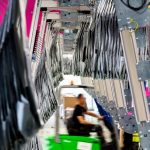If you can’t see the driver’s mirrors, they can’t see you. That’s the fundamental rule of truck safety. Large trucks have extensive blind spots called no-zones. These areas exist on all four sides of the vehicle but are most dangerous on the right side and rear.
A vehicle that’s invisible to the truck driver might suddenly be struck when the truck changes lanes or turns. Understanding where these no-zones are located helps you stay out of them and avoid becoming another statistic in preventable truck accidents.
Where these no-zones are located and how accidents happen reveals that most no-zone collisions are preventable through driver awareness and truck driver responsibility. A truck driver has a duty to check mirrors and turn to look before changing lanes or turning. When they fail that duty, vehicles in no-zones get hit. Those collisions are often catastrophic because of the truck’s size and weight.
Learning practical safety takeaways about truck blind spots and no-zones helps protect you from disappearing from a truck driver’s view. Because big rigs have a large blind spot, understanding truck blind spots and no-zones turns invisible danger into manageable risk.
Where Trucks Can’t See You
Front blind spots exist directly in front of the cab. A vehicle ahead of a truck might not be visible to the driver. This is particularly dangerous at intersections where a truck is turning. The truck driver doesn’t see vehicles directly in front.
Rear blind spots are massive. A truck’s rear extends far back. Vehicles following too closely disappear from the driver’s view entirely. Multiple car lengths can fit in the rear no-zone where the driver can’t see anything.
Right side blind spots are notoriously dangerous. Most of the truck’s right side is invisible to the driver. A car passing on the right can disappear entirely. Merging vehicles on the right vanish from sight. The right side is where most no-zone collisions happen.
Left side blind spots exist but are smaller than right-side zones. Still, a vehicle lingering on the left side might not be visible. How truck size and trailer length worsen no-zones is that bigger rigs create larger blind spots. A fifty-foot trailer creates a massive rear no-zone. Common merge and lane-change scenarios put vehicles directly into no-zones where truck drivers can’t see them.

When No-Zones Turn Deadly
Pedestrian, cyclist, and car fatalities happen when vehicles occupy no-zones during truck maneuvers. A pedestrian crossing behind a truck gets hit during a backup. A cyclist riding alongside gets clipped during a lane change. A car merging gets struck by a truck that didn’t see them.
Turning and backing accidents concentrate the danger. When trucks turn right, they swing wide. Vehicles on the right side get crushed. When trucks back up, they might hit pedestrians or vehicles in the rear no-zone. These scenarios play out regularly in urban areas and parking lots.
Real Houston case examples show fatal no-zone collisions happening regularly. Cyclists hit during lane changes. Pedestrians struck while trucks backing. Cars pushed across lanes by trucks that didn’t see them. These aren’t theoretical risks. They’re documented tragedies.
Avoiding Blind-Spot Collisions
Staying visible means following the mirror rule. If you can see the truck driver’s mirrors, they can see you. If you can’t see the mirrors, assume they can’t see you. Pass trucks quickly rather than lingering in no-zones. Don’t stay alongside trucks any longer than necessary.
Passing and following-distance rules protect you. Don’t follow trucks too closely. Don’t linger when passing. Complete your pass and move ahead. Maintain distance that gives you reaction time if the truck changes lanes or brakes suddenly.
Predicting wide turns means understanding that trucks turn wide. A truck turning right might swing left first to clear the corner. Drivers unfamiliar with truck turning patterns get surprised by this maneuver. Understanding it prevents getting caught in the turning path.
Holding Truck Drivers Accountable
Duty to check mirrors and sensors exists in law and regulation. Truck drivers must check mirrors before changing lanes. They must turn to look before turning. They must verify no-zones are clear before maneuvering. When they fail that duty, they’re negligent.
Blind-spot training and technology like cameras and radar help prevent accidents. Some trucks have systems that alert drivers when vehicles are in no-zones. These systems supplement but don’t replace driver responsibility. Drivers still must look and confirm the area is clear.
Proving negligence in claims means showing that the truck driver failed to check before maneuvering and that failure caused the collision. Evidence includes witness statements, truck inspection records, electronic logs showing the truck’s movements, and crash reconstruction showing the vehicle was in a no-zone.
Conclusion
Recapping danger zones and defensive tactics means understanding that no-zones are real and dangerous. Knowing where they are protects you from entering them unknowingly.
Promoting awareness and visibility means driving with specific knowledge of no-zone locations and maintaining visibility in truck drivers’ sight lines. That awareness and visibility save lives.
Understanding knowledge of truck blind spots no-zones to prevent deadly mistakes means driving near large trucks with heightened awareness and keeping yourself visible and safe.






